By Dan Smith - Genitron.com
The Company -
Fabrique Nationale
AKA FN-Herstal
AKA FNH-USA
Located in Herstal, Belgium
U.S. plant in Columbia, South Carolina
Many people may not know that today FN actually owns the likes of Winchester and Browning. FN's relationship with Browning goes back over a hundred years and spawned the venerable Hi-Power pistol. FN took up U.S. residence back in 1982 when it won a contract to manufacture automatic weapons for the U.S. military, building a manufacturing plant in Columbia, South Carolina. A few years later FN established a commercial foothold in the U.S. when it acquired its US partner, Browning. In 1998 FN became its own U.S. commercial presence when it established FNH-USA in McLean, Virginia.
So, it's no surprise that FN's new polymer handgun was actually first introduced in 2003 and marketed by Browning as their Browning PRO model. In 2006 the gun was re-introduced by FNH-USA as the FNH FNP.
The Gun -
Polymer frame semi-automatic
Hammer-fired double-action (DA/SA) trigger
Length - 7.4 inches
Height - 5.4 inches
Width - 1.55 inches
Weight - 26.7 ounces
Barrel Length - 4 inches
Caliber tested - .40S&W
Capacity - 14 + 1 rounds
MSRP - $629
Street Price - $540
In many respects the FNP is a somewhat unremarkable entry into the myriad of polymer frame pistols being produced today. Its weight, size and capacity are on par with its peers. It has similar feature sets such as interchangeable palmswell inserts, ambidextrous controls and an accessory rail. Some of the features are even under-performers, such as only two choices in palmswell inserts.
So, what sets this gun apart from its contemporaries? Well, one key feature is that, while most polymer frame pistols on the market today are striker fired and either double-action only, or single-action, the FNP is a true hammer-fired double-action(DA/SA) pistol. It has an external ring-type hammer with comfortable thumb serrations for manual cocking, and a trigger with a double-action pull of roughly 9 pounds and a single-action pull of under 4 pounds.
As with most double-action pistols the FNP is equipped with ambidextrous decocking levers. Activating the decocking lever drops the hammer to a half-cock position on the sear preventing it from resting on the firing pin, and resets the trigger to double-action (DA) mode. While many double-action (DA/SA) pistols also have a trigger disengaging safety setting, the FNP does not. Once a round is chambered, the gun is ready to fire either in single-action or double-action mode. This always ready to fire condition is probably why FN says the FNP is targeted primarily for military, police, security markets as well as personal self-defense. This always-on firing mode though, is common with the striker-fired polymer pistols.
The gun comes equipped with standard white 3-dot combat sights. Both front and rear sights are dovetailed into the slide, providing an upgrade path to night sights if desired. The sight radius is 6 inches over a 4 inch barrel. The slide is offered in either a stainless or matte black finish with cocking serrations at the rear only. The slide incorporates an external extractor that FN states also acts as a loaded chamber indicator. I found this indicator function to be entirely inadequate though, particularly in a low-light or stress situation (see the sidebar).
The gun's take-down lever is machined from cast aluminum while the slide-stop and ambidextrous decocking levers are constructed from stamped steel. The flat-wire wound recoil spring is captive on its aluminum guide rod. The trigger is polymer along with the frame. The slide rides on an extended 4-point steel rail system embedded into the polymer frame. This rail system has more surface area contacting the slide than what is found in most of the other polymer pistols. The lowered and extended beavertail does a good job protecting the web of the hand, but sets the center of the barrel about 1-3/8 inches above the finger-point. That parallax is 1/4 inch higher than the Glock, but is the same as the Springfield XD.
The polymer frame sports a single-notched accessory rail in front of its rounded trigger guard. The grip has checkered front and back straps with textured ambidextrous side panels. The interchangeable palmswells are limited to just two options: a "standard" insert and a somewhat unappealing flat "slim" insert for smaller hands. The palmswell is secured to the grip with a small screw near its bottom end, requiring a screwdriver to remove and install. The thin walls of the polymer frame's magazine well allow for a double-stack magazine, giving the gun its high cartridge capacity.
Shooting -
A day at the range with this gun brought many pleasant surprises. The gun was well balanced, had a solid feel - no rattles, and was quite comfortable in the hand (I used the standard palmswell insert). The double-action trigger draw was about 5/8 inch to the sear break, but was smooth with a consistent 9 pound pull. The single-action draw had about 1/2 inch of take-up itself before the sear broke at just under 4 pounds. It was also smooth and consistent.
More exciting though was the natural feel and fit of the gun. Right off the bat my groups at 7 and 25 yards were as good as with my most favorite shooter, if not better. No adjusting my stance, my grip , my pull... the gun felt like an old friend. I fired 500 rounds of a mix of FMJ and JHP cartridges without issue. As with just about all polymer frame pistols the center of balance adjusted up as I emptied the magazine, making target re-acquisition a little slower with the last 5 rounds or so.
As I stated before, the loaded-chamber indicator on the gun's external extractor was almost impossible to see. I had better luck reaching over with my weak hand and feeling the subtle extractor protrusion. But in my opinion, ultimately pulling back a bit on the slide and seeing brass in the chamber is the surest way to check if your gun is loaded.
The large round magazine release button was relatively easy to reach with my thumb, and the magazines dropped quickly and cleanly for reloading. Manual cocking of the hammer was quite comfortable with the rounded and serrated hammer spur.
Left-handed shooting was alright. The ambidextrous decocking lever is exactly the same on both sides. Cartridge extraction cleared me every time. But, I had issues with the "reversible" magazine release button. Although FN states that the magazine release button is reversible, there were no instructions in the manual on how to do it. A call to FN's support line got me instructions on how to pull the release button spring and reverse the button. But, try as I might with a variety of tools, I was unable to pull the release button spring from the magazine catch inside the magazine well as instructed. I must say though that the FNH-USA support guys really tried to help, even to the extent of having me ship the gun to them to do the job for me, if I wanted.
Conclusion -
I found the FNP to have all the basic features of a quality handgun. It's obviously well made and extremely comfortable in the hand. It is hammer fired with a smooth double-action (DA/SA) trigger. It has a high capacity and is consistently accurate. But as stated before, its features are nominal if not lacking. For instance it has a decocking lever, but no safety. It has interchangeable palmswells, but only in two sizes. It has an accessory rail, but with only a single notch which limits accessory options.
Perhaps that is why FN recently introduced the FNX series of pistols. Presently offered in 9mm and .40S&W the FNX could easily be mistaken for the FNP at first look. This is because for all intents and purposes the FNX is the FNP, just with improvements on those features lacking in its predecessor. They have added a safety along with the decocker. They have doubled the interchangeable palmswell options to four. The accessory rail is now MIL-STD 1913 compliant. They have enlarged the magazine release button and added front slide cocking serrations. And, they did all this without significantly increasing the cost.
So, would I buy an FNX over the FNP? Well the answer isn't simple, and that's why FN continues to produce the FNP along with the newer FNX. Here's why, at least in my humble opinion. First, the safety - there are many shooters that prefer pistols without a manual safety. The Glock's popularity for instance is a perfect example of that. And when it comes to those interchangeable palmswells, I'll bet that ninety percent of the market would be covered with the FNP's standard insert and the other ten percent would be satisfied with the slim insert. Of the guns I own with interchangeable palmswells, I use the default insert in all of them. As far as the accessory rail goes, it all depends on if you are an accessory buff or not. I don't use mounted accessories on my pistols, so I could care less if the rail is MIL-STD or not. The front slide serrations and enlarged magazine release on the FNX... OK those are nice additions.
But, all this means is that FN is being smart and providing choices. If you want clean, simple, tactical, then choose the FNP. If you are looking for that additional safety or a flexible base for accessories, then choose the FNX. IF you think you need an incremental change in the grip size, then consider the FNX.
One big thing that I would like to comment on is FN's policy to sell all of their pistols in nice hard cases with three (yes three) magazines. In my opinion this really skews their pistols' price points favorably. I can't have a semi-automatic pistol without at least two magazines. Some of the more pretentious and expensive guns on the market (SIG is a good example) have a premium price and still only come with a single magazine. An additional magazine will run you another $35 to $45. To me this is just a way of squeezing me for more money on a gun that should have come with at least two magazines anyway. So, kudos to FN.
All-in-all I give the FNP a positive rating. It is just average on certain features, but when it comes to handling and shooting it is ultimately an accurate and reliable pistol - one that I will keep in my permanent collection.
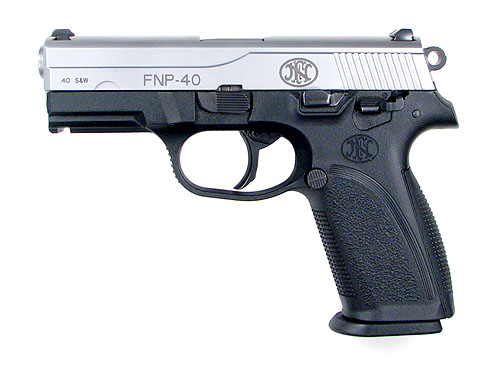
The FNH FNP is a polymer frame semi-automatic pistol manufactured and sold in the U.S. by FNH-USA, a subsidiary of Fabrique National of Herstal, Belgium.
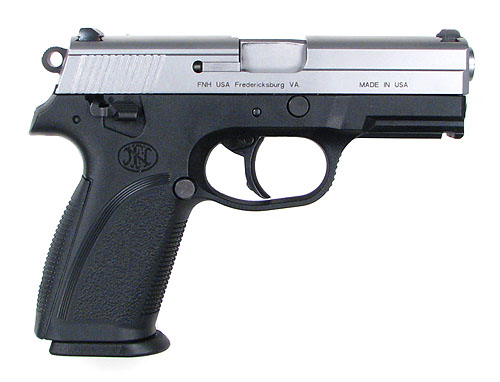
First marketed in 2003 under its Browning label as the PRO series, FN re-introduced the handgun in 2006 under its parent label, FNH, as the FNP series.
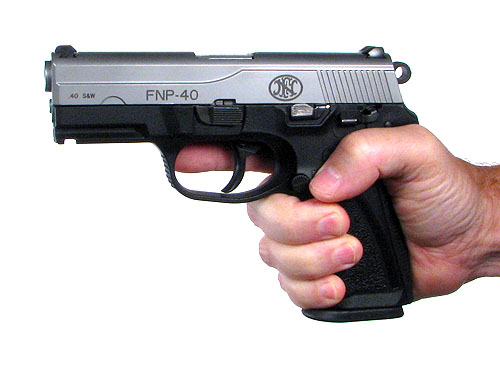
Unlike many polymer frame pistols such as the Glock, Smith & Wesson M&P and Springfield XD, the FNP is a hammer-fired double-action(DA/SA) pistol.
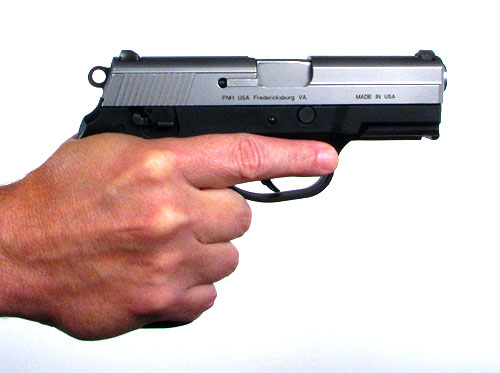
The FNP's lowered and extended beavertail does a good job protecting the web of the hand, but sets the center of the barrel about 1-3/8 inches above the finger-point.
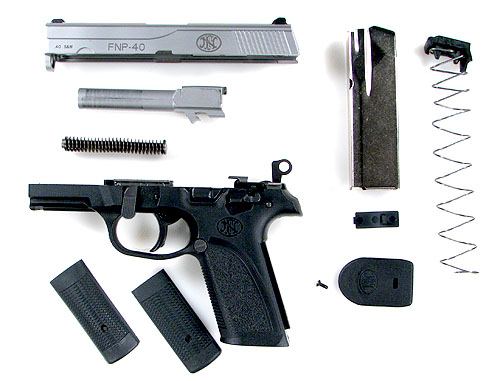
The FNP-40 taken down to its field serviceable parts. The interchangeable grip palmswells require a small screwdriver to remove.
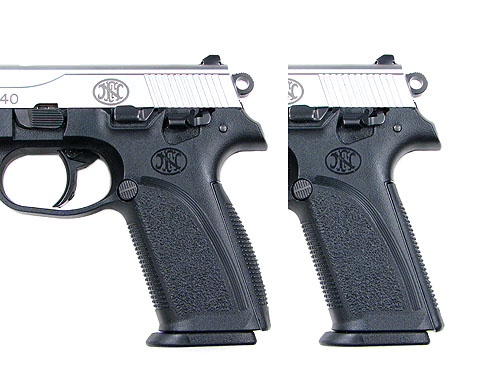
The FNPs polymer grip has just two interchangeable palmswell inserts: a "standard" insert and a somewhat unappealing "slim" insert for smaller hands. A small screwdriver is required to change the inserts.
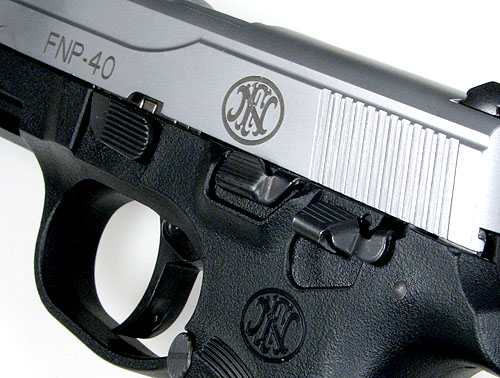
While the FNP's takedown lever is machined from cast aluminum, the slide stop and decocking levers are constructed from stamped steel.
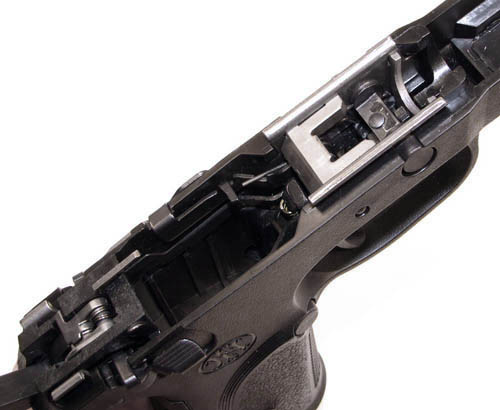
The FNP's slide rides on an extended 4-point steel rail system embedded into the polymer frame. This rail system has more surface area contacting the slide than what is found in most of the other polymer pistols.
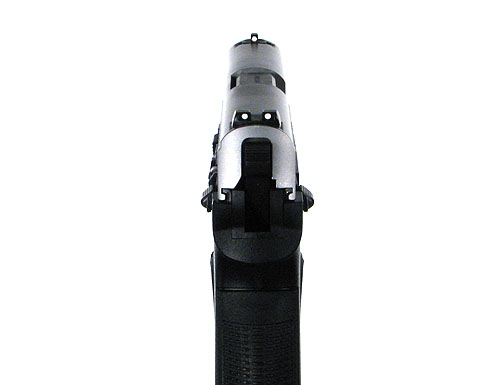
The FNP employs standard white 3-dot combat sights dovetailed into the slide. The gun's widest point is across its ambidextrous decocking levers - just a hair over 1.5 inches.
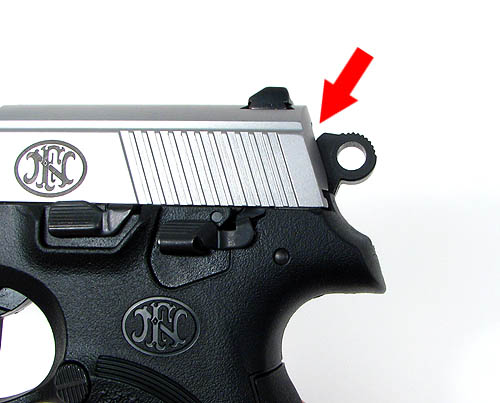
The decocking lever takes the cocked pistol from single-action mode to double-action mode and drops the hammer to a firing-pin blocking half-cocked position. There is no manual safety.
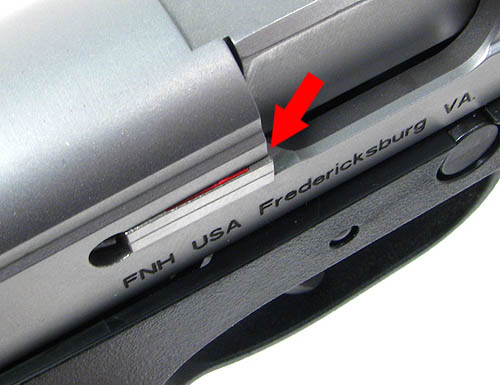
FN states that the FNP's external extractor also acts as a loaded chamber indicator. But, the red marking on top of the extractor intended for this use is barely visible when the chamber is loaded. The extractor's protrusion is very subtle even to the touch.
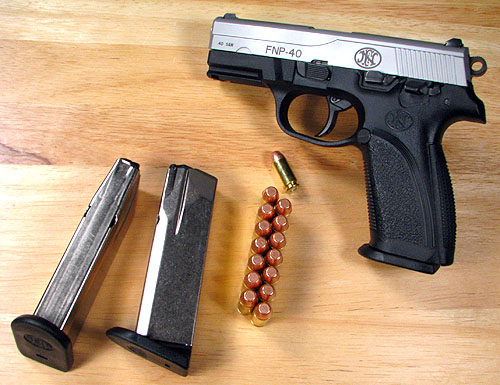
The FNP-40 ships in a hard case with three (yes three) 14-round magazines.